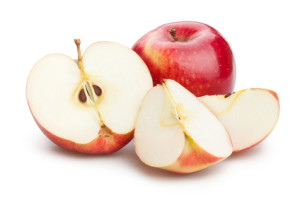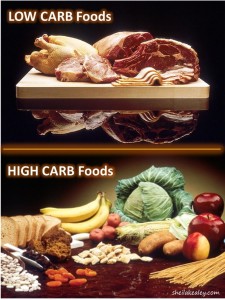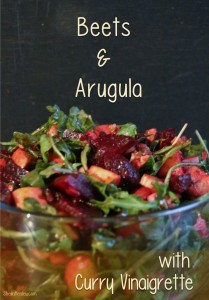This week, read about sports nutrition for stress fractures, 5 great Fall foods, the accuracy of running apps, healthy eating habits for lazy college students, new research into intervals and periodization, Vegan glam, Isagenix, and more.
Prone to stress fractures? Consider your sports nutrition.
Weight bearing exercise is generally good for bone health, because bone responds to the stress of exercise by becoming stronger. But some athletes are more prone to stress fractures than others, for example active women who are underweight and amenorrheic often have decreased bone mineral density. Although a variety of factors contribute to fractures, recent research suggests that what an athlete eats before, during, and after exercise can influence bone turnover. Making the right choices could potentially offset bone loss and prevent stress fractures.
Carbohydrates during exercise might benefit bones. It is already firmly established that eating carbohydrates helps endurance performance; this week a study published in the Journal of Applied Physiology looked at how carbohydrates (8% glucose solution, similar to most sports drinks) during exercise influence bone metabolism during a strenuous 2-hour treadmill run. Researchers found that compared to placebo, runners who ingested carbohydrates during their run had reduced markers of bone resorption (breakdown). The effect was small and requires further study, but if you’re someone who goes without food/carbs during long workouts (and are prone to stress fractures), it seems this would be an good strategy to adopt, especially since carbohydrates will help other performance measures as well. (Journal of Applied Physiology, October 2015)
As I’ve reported before, another strategy for bone health is a calcium-rich meal before exercise. Athletes lose calcium through sweat during exercise, which puts them at risk for bone loss, especially if their activity is non impact since it doesn’t benefit bones. A study in female cyclists found that eating a dairy-rich meal 90 minutes before riding can counter bone loss. The pre-ride calcium-rich meal keeps blood calcium levels stable, so your body doesn’t borrow calcium from your bones to replace what’s lost in sweat. (PLOS ONE, May 2015)
 5 Foods That Taste Better in October Than They Will All Year. Hard to limit it to 5, but it’s a great time to enjoy apples, pears, pumpkins, persimmons, & grapes. (Time)
5 Foods That Taste Better in October Than They Will All Year. Hard to limit it to 5, but it’s a great time to enjoy apples, pears, pumpkins, persimmons, & grapes. (Time)
Physics of falling says professional athletes are running wrong. A Norwegian physicist theorizes that runners could be much faster if they ran in a way that used gravity (Proceedings of the Royal Society, Sept 2015). His study was quickly shot down by Alex Hutchinson (Runner’s World) here.
How accurately do running apps track your distance? A good explanation of the measurement error you can expect to find with GPS apps. (Beth Skwarecki, Lifehacker).
Walking quieter routes to work can avoid peaks in air pollution. Commuting to work by walking on quieter side streets rather than main roads can help people avoid exposure to peaks in harmful air pollution. (European Respiratory Society’s International Congress, 2015.)
33 Healthy Eating Habits Lazy College Students Will Appreciate. A lot of these tips are actually pretty good! (Buzzfeed)
What’s better – a long walk or a short stair climb? Both are good, but stairs are more intense physical activity and you will have more health benefits for a shorter activity time. (Gretchen Reynolds, New York Times).
21 “easy” food swaps you can make now without missing out. This is a great takedown of an article full of nutrition misinformation. Before you go swapping coconut oil for the fat in your recipe, sea salt for regular salt, or rice malt syrup for sugar, read this article. (Diane Chard, Bite My Words).
For coaches & athletes – best interval formats and periodization. Alex Hutchinson reports on a talk by exercise physiologist Stephen Seiler from the Norwegian Olympic federation (he often studies xc skiers) looking at two questions that most coaches and athletes ponder: (1) how do the intensity and duration of intervals interact? and (2) does periodization matter? The article provides a nice summary of complex questions. You can view Seiler’s talk here. (Alex Hutchinson, Runners World).
‘Vegan Glam’! Where Is the Vegan Julia Child? New York Times readers respond to article about trendy vegans. (New York Times)
Volkswagen emissions cheating caused $100 million in health costs. The far-reaching impact of a company’s horrible action. (Grist)

Unsaturated fats, high-quality carbs lower risk of heart disease. Although “butter is back” was a popular headline, the study that prompted this has been called into question. In a new study, Harvard researchers debunked a controversial paper suggesting that saturated fat intake did not affect heart health, and note that the quality of both the fat and carbohydrate consumed are important. When they compared saturated fat intake with intake of other types of fats and different types of carbohydrates, they found that replacing saturated fats with refined carbohydrates didn’t benefit heart health, but replacing saturated fats with unsaturated fats (found in nuts, seeds, fatty fish, and vegetable oils) and/or nutritious carbohydrates did benefit heart health. In practical terms, your entire diet is important. . . it doesn’t help if you limit butter, bacon, and burgers if you replace those foods with white bread, cookies and processed carbs, but replacing those foods with nuts, fatty fish, and healthy carbs will benefit your heart. (Sept 28, 2015, Journal of the American College of Cardiology).
Often carbohydrates are lumped into one category, which leads to much misunderstanding, because the health impacts of various types of carbs can be dramatically different (soda is not the same as oats). It’s critical to distinguish healthy carbohydrates (vegetables, legumes, whole grains), and generally unhealthy ones (refined/processed).
Calcium supplements do not prevent fractures. Two new studies looked at calcium intake and fracture risk in people over 50 years of age. One study compared supplementary dietary calcium to calcium supplements and found only a small but non-clinical increase in bone-mineral density. Another study conducted a systematic review of the research and found that the evidence for preventing fractures from increased dietary calcium or dietary supplements was weak. The editorial calls for revisiting guidelines for calcium supplementation (BMJ).
Why taller people are at greater risk of cancer. While it is well known that being overweight contributes to cancer risk, the relationship between height and cancer risk is not as well known or understood. This is a good explanation of a complex topic. (World Cancer Research Fund).
Lose weight, create wealth, join Isagenix!? Ah huh… A nutrition scientist’s view of the weight loss scam. (Cocoa & Bliss).
Previous articles on Isagenix . . .
- Does Isagenix Help You Lose Weight, or Lose Your Money? (Fooducate)
- Isagenix under the microscope. (CHOICE online)
- Isagenix Study Is Not Convincing (Science-Based Medicine)
- Defending Isagenix: A Case Study in Flawed Thinking (Science-Based Medicine)
New Recipe: Beets & Arugula in a Curry Vinaigrette
 Sweet and colourful, beets will certainly brighten up any meal! Their brilliant red hue comes from pigments called anthocyanins, powerful antioxidants studied for their disease-prevention potential. Beets, arugula, and celery are also good sources of dietary nitrates, which have been linked to improved athletic performance and blood pressure regulation.
Sweet and colourful, beets will certainly brighten up any meal! Their brilliant red hue comes from pigments called anthocyanins, powerful antioxidants studied for their disease-prevention potential. Beets, arugula, and celery are also good sources of dietary nitrates, which have been linked to improved athletic performance and blood pressure regulation.
This beet and arugula salad is great anytime, but terrific when fresh beets and apples are in season. It takes a little longer to prepare than my typical salads, but if you cook the beets in advance it is pretty quick to put together.
Share This: